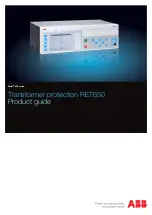
Functions
2.17 Automatic Reclosure Function (optional)
SIPROTEC, 7SD5, Manual
C53000-G1176-C169-5, Release date 02.2011
322
In control mode
PICKUP ...
(With PICKUP...), different dead times can be set for every reclose cycle after 1-
, 2- and 3-phase faults. The pickup diagram of the protection functions at the instant when the trip command
disappears is the decisive factor. This mode allows the dead time to be made dependant on the type of fault in
the case of 3-pole tripping applications.
Blocking reclosure
Different conditions lead to blocking of the automatic reclosure function. No reclosure is possible, for example,
if it is blocked via a binary input. If the automatic reclosure function has not yet been started, it cannot be started
at all. If a reclosure cycle is already in progress, dynamic blocking takes place (see below).
Each individual cycle may also be blocked via binary input. In this case the cycle concerned is declared as
invalid and will be skipped in the sequence of permissible cycles. If blocking takes place while the cycle con-
cerned is already running, this leads to aborting of the reclosure, i.e. no reclosure takes place even if other valid
cycles have been parameterized.
Internal blocking signals, with a limited duration, arise during the course of the reclose cycles:
The reclaim time
T-RECLAIM
(address
3403
) is started with each automatic reclosure command. The only ex-
ception is the ADT mode where the reclaim time can be disabled by setting it to 0 s. If the reclosure is success-
ful, all functions of the automatic reclosure function return to the idle state at the end of the reclaim time; a fault
after expiry of the reclaim time is treated as a new fault in the power system. If the reclaim time is disabled in
ADT mode, each new trip after reclosing is considered as a new fault. If one of the protection functions causes
another trip during the reclaim time, the next reclosure cycle will be started if multiple reclosure has been set.
If no further reclosure attempts are permitted, the last reclosure is regarded as unsuccessful in case of another
trip during the reclaim time. The automatic reclosure function is blocked dynamically.
The dynamic lock-out locks the reclosure for the duration of the dynamic lock-out time (0.5 s). This occurs, for
example, after a final trip or other events which block the auto reclose function after it has been started. Re-
starting is blocked during this time. When this time expires, the automatic reclosure function returns to its qui-
escent state and is ready for a new fault in the network.
If the circuit breaker is closed manually (by the control discrepancy switch connected to a binary input, the local
control functions or via one of the serial interfaces), the automatic reclosure function is blocked for a manual-
close-blocking time
T-BLOCK MC
, address
3404
. If a trip command occurs during this time, it can be assumed
that a metallic short-circuit is present (e.g. closed earth switch). Every trip command within this time is therefore
final. With the user definable logic functions (CFC) further control functions can be processed in the same way
as a manual–close command.
Interrogation of the Circuit Breaker Ready State
A precondition for automatic reclosure function following clearance of a short-circuit is that the circuit breaker
is ready for at least one OPEN-CLOSE-OPEN-cycle when the automatic reclosure circuit is started (i.e. at the
time of the first trip command). The readiness of the circuit breaker is signalled to the device via the binary input
„>CB1 Ready“
(No. 371). If no such signal is available, the circuit breaker interrogation can be suppressed
(presetting of address
3402
) as automatic reclosure function would otherwise not be possible at all.
In the event of a single cycle reclosure this interrogation is usually sufficient. Since, for example, the air pres-
sure or the spring tension for the circuit breaker mechanism drops after the trip, no further interrogation should
take place.
For multiple reclosing attempts it is highly recommended to monitor the circuit breaker condition not only prior
to the first, but also before each following reclosing attempt. Reclosure will be blocked until the binary input
indicates that the circuit breaker is ready to complete another CLOSE-TRIP cycle.
The time needed by the circuit breaker to regain the ready state can be monitored by the 7SD5. This monitoring
time
CB TIME OUT
(address
3409
) starts as soon as the CB indicates the not ready state. The dead time may
be extended if the ready state is not indicated when it expires. However, if the circuit breaker does not indicate
its ready status for a longer period than the monitoring time, reclosure is dynamically blocked (see also above
under margin heading „Reclosure Blocking“).












































